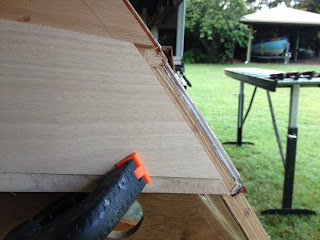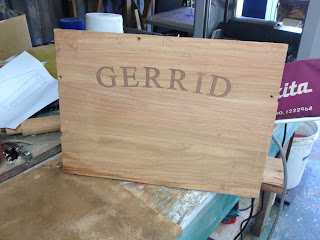Over the last few months I have been rowing my Acorn 15 regularly because I enjoy it and I need the exercise. My Acorn 15 rowing boat has a fixed rowing position and I decided that it would be a good idea to try rowing with a sliding seat to get a more complete workout. One option would have been to modify the Acorn 15 by fitting a sliding seat. I wasn't keen on doing this because I didn't want to spoil the look of the Acorn 15. It would also have been a compromise solution.
While these ideas were going round in my head I came across the photo below taken by my friend and fellow member of the Wooden Boat Association of Queensland Ian Primrose.
The photo is of a Classic Derwent Skiff designed by Allan Witt of a company called Row and Sail based in Tasmania.
I liked the appearance of this boat which is configured with a sliding seat as shown. The rowing position can be moved forward and an additional seat added for a passenger if desired.
This version of the Derwent Skiff is 5.5 metres (18 feet) long and should weigh around 38 kg. This is less than half the weight of my Acorn 15.

Monday, 26 March 2018
Planking Complete
On the middle plank on the other side of the boat I managed to cut the two scarfs on the same side of the centre section. I had already cut the scarfs on the fore and aft sections so I had to cut the incorrect scarf off and make a new one. Cutting the scarf off lost 50mm of the plan's length; the new scarf effectively lost another 50mm. The planks in the kit are cut with some extra lengths to allow a damaged scarf to be recut but doing this would only lose part of the scarfs 50mm length. The result of this is shown here.
The only way to recover from this blunder was to and an extension to the end of the bow section. This resulted in two scarf joints being close together. This is another nail in the coffin of the varnished boat idea and I will now paint the outside of the boat.
In this next phot the C clamps are clearly visible as are some home made screw clamps where the C clamps can't be used because there isn't enough clearance between the hull and the mold.There are also a couple of good old metal screw clamps in there and a couple of V clamps holding the planks to the stem. These V clamps simply hold by friction but only work on a shallow angle.
Here's the fully planked hull.
at this point I removed all the temporary screws holding the keel, inner stem and transom to the mold and tried to lift the hull off the mold. It wasn't easy because the squeezed out epoxy inside the hull was sticking to the sticky tape and plastic which was in turn stuck to the mold. Fortunately the protective layer of tape and plastic had done its job and I was able to lift the hull up.
While waiting for the planking glue to go off I have assembled the "buoyancy tank". This is a trapezoidal shaped box which sits on the keel in the middle of the boat with the sliding seat mounted on top of it and the outrigger arms attached to the aft end of the box. The top, bottom and ends have corner strips glued to them and finally the sides are glued on. In this photo the sides are being glued in place - a tricky clamping exercise to hold the ends of the side panels down. The tape was sufficient to pull the joints together along the long edges.
After cleaning up the box I couldn't resist a test assembly of the box, the outrigger arms and the sliding seat. Now this weird shaped box begins to make more sense. there is auite a bit more work to be done on this assembly and I will do that while waiting for the epxoy to set on the outer keel, cutwater and skeg.
Friday, 16 March 2018
Transom and Garboard Planks
Now you are probably wondering about the name and why. Remember, Google is your friend! You can't see it but the same inlay is on the other side of the board.
Before the transom could be glued to the end of the keel the keel was lifted off and the edges cleaned up, ie excess epoxy removed. The protective tape, so the hull doesn't stick to the mold was replaced, and the keel put back on the mold. The transom was glued to the end of the keel and screwed to the mold through the corners which will eventually be removed.
Next step was to bevel the edges of the transom so that the planks will lie nicely on it and get a good glue joint. This bevel is tricky, the angle changes continuously. I started out with the power plane with the wooden arm. By riding the arm on the stringers and the next frame the plane cut the correct angle but was awkward to use on a convex curved surface. Then I noticed that my belt sander had a tapped hole in the side so I made a wooden arm to fit it. This worked like a charm and I made a perfect bevel quite quickly.
Here are the two tools with their outrigger arms.
Clamping the planks to each other along the stringers it tricky because a lot of clamps with a long reach are needed. Allan Will suggested C clamps and wedges. I have used this approach before but needed to make a new set. Here they are, various thicknesses of scrap plywood (10, 12, 14, 16 mm thick) cut on the bandsaw. THere are 50+ of them in the stack. They are used with wedges which I have a heao from previous boats.
Preparing the garboard planks (3 each side) involved cutting 50 mm long scarfs on the ends, a rebate or gain at the bow and stern and, because the transom is curved where the planks land cuts had to be made along the inside of the planks so it would bend to the curve.
Here a rebate is being cut in the standard way using a rebate plane.
Here is a plank with the cuts, they are about 12 mm apart and 200 mm long.
Here is a view from the stern with 4 out of the 6 planks fitted. The planks are held down by screws along the keel where the holes will be covered by the outer keel.
This is a view from the bow with the forward garboard sections being trial fitted. More of the Vee shaped blacks were needed to pull the planks together around the stem but using them avoided screw holes which would have been visible in the finished boat.
Last photo shows the stern section of the middle plank being glued in place. Pulling this planks down onto the curved transom was difficult and needed some messy work with a long clamp and a spanish windlass.
Wednesday, 7 March 2018
The Kit Arrives. Inner Stem, Keel and Outriggers
Inside the pack were four and a half sheets of 6mm ply. Each sheet had been CNC cut with the pieces held in the sheet with short tabs. Here are the four full sheets - you can enlarge the photos by double clicking on them.
First job was to laminate the 3 layers of 6mm ply that form the inner stem. Where the pieces join there is aan individual puzzle joint so the pieces can only be assembled in the correct order. Here they are wrapped around the mold with plastic to stop them sticking to the mold and plenty of clamps.
While the epoxy was setting on the stem I laminated the five pieces that make up one of the outrigger arms. There are 3 pieces of 6mm ply with outer layers of 4mm solid timber. The laminations are kept in place by the bolt at the left hand end of the jig. With this pulled tight the clamps are applied progressively to the right.
Here is the complete lamination held in a pipe clamp to stop (or reduce) springback until the epoxy is hard.
The rest of the keel is made up of 2 layers of 6mm ply put together in sections and glued with epoxy. No photo of that but essentially the same as the stem. Once the stem and keel are glued (and screwed to the mold) the edges have to be bevelled so the first plank can be glued to them. I did this with a Ryobi cordless planer fitted with an arm the outside of which is in line with the base of the plane.By running the arm along the lower stringer (where the plank will sit the plane is held at the correct angle for the bevel.
Here are the pair of outrigger arms after some initial cleanup. When in the boat the oarlocks will be in the hole at the rounded end, the far ends are joined together at the keel and the mid point is bolted to the gunwale.
Next step is to make the transom, fit it to the mold and glue it to the end of the inner keel. While that glue is setting the aft end of the garboard planks has to be prepared.
Gone to a New Home.
Sadly I have parted with my Derwent Skiff. I loved the feeling of flying over the water that came with the long oars and sliding seat but t...

-
Here is that last photo of the build process. The boat is sitting on the trailer that was built for my Acorn 15. The boat is supported by th...
-
Sadly I have parted with my Derwent Skiff. I loved the feeling of flying over the water that came with the long oars and sliding seat but t...
-
With the cross supports fitted under the well decks the final cleaning up of the compartments was a fiddly job because power sanders couldn...





























